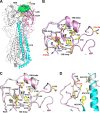Hemagglutinin receptor specificity and structural analyses of respiratory droplet-transmissible H5N1 viruses
- PMID: 24173215
- PMCID: PMC3911709
- DOI: 10.1128/JVI.02690-13
Hemagglutinin receptor specificity and structural analyses of respiratory droplet-transmissible H5N1 viruses
Abstract
Two ferret-adapted H5N1 viruses capable of respiratory droplet transmission have been reported with mutations in the hemagglutinin receptor-binding site and stalk domains. Glycan microarray analysis reveals that both viruses exhibit a strong shift toward binding to "human-type" α2-6 sialosides but with notable differences in fine specificity. Crystal structure analysis further shows that the stalk mutation causes no obvious perturbation of the receptor-binding pocket, consistent with its impact on hemagglutinin stability without affecting receptor specificity.
Figures




References
-
- WHO-CSR 13 May 2011. Cumulative number of confirmed human cases of avian influenza A/(H5N1) reported to WHO. http://apps.who.int/csr/disease/avian_influenza/country/cases_table_2011....
-
- Ungchusak K, Auewarakul P, Dowell SF, Kitphati R, Auwanit W, Puthavathana P, Uiprasertkul M, Boonnak K, Pittayawonganon C, Cox NJ, Zaki SR, Thawatsupha P, Chittaganpitch M, Khontong R, Simmerman JM, Chunsutthiwat S. 2005. Probable person-to-person transmission of avian influenza A (H5N1). N. Engl. J. Med. 352:333–340. 10.1056/NEJMoa044021 - DOI - PubMed
-
- Wang H, Feng Z, Shu Y, Yu H, Zhou L, Zu R, Huai Y, Dong J, Bao C, Wen L, Yang P, Zhao W, Dong L, Zhou M, Liao Q, Yang H, Wang M, Lu X, Shi Z, Wang W, Gu L, Zhu F, Li Q, Yin W, Yang W, Li D, Uyeki TM, Wang Y. 2008. Probable limited person-to-person transmission of highly pathogenic avian influenza A (H5N1) virus in China. Lancet 371:1427–1434. 10.1016/S0140-6736(08)60493-6 - DOI - PubMed
Publication types
MeSH terms
Substances
Grants and funding
LinkOut - more resources
Full Text Sources
Other Literature Sources
Medical

